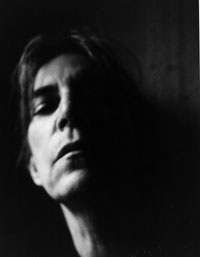“I feel like Chris Farley,” Patti Smith said with a laugh, recalling his awestruck attempt at interviewing Paul McCartney during a Saturday Night Live sketch. Thursday, she opened a show of her photographs at the New Orleans Museum of Art with a talk on her relationship to photography, and at some point, the fan in her couldn’t help but come out. As she showed slides of photos by Alfred Steiglitz, Brancusi, Tina Modotti and Robert Frank, she joked, “That’s awesome.”
Smith donated 45 of her photos to the museum’s permanent collection, and they are on display until June 3. Included in the collection are photos such totemic objects as Herman Hesse’s typewriter, Virginia Woolf’s garden, Jack Kerouac’s Big Sur scrolls, Rimbaud’s atlas, Blake’s life mask, and in a rare nod to modernity, the guitar of My Bloody Valentine’s Keith Shields.
“I’m not Catholic, but I like their sense of icons,” she says.
Smith’s first recollections of photography came when she cut clothes out of a Sears catalog for paper dolls. When she happened upon copies of Vogue and Bazaar, she thought about those photos next to those in the catalog. “I thought that Sears was quite wanting,” she said. “I believe it was one of my first aesthetic decisions.”
Her recent book, Just Kids, documents Smith’s relationship with photographer Robert Mapplethorpe, and the talk touched on that time though none of his photos are included in the show. When she showed photos of herself taken by Mapplethorpe, she pointed out her face in the shots and said, “I am doing my best to be his Georgia O’Keefe,” referring to her efforts as model for Steiglitz.
Her own immersion in photography came in 1994 after the deaths of her husband Fred “Sonic” Smith and her brother Todd. Photography became a creative outlet, one she could do on her own, as opposed to music. She acknowledged in the talk her relatively unschooled approach to photography, focusing more on the information in the shot than light. “I love the 19th Century amateurs; that’s who I aspire to in photographs,” she said.
Most of the photos in the collection were shot with the Polaroid Land 250 camera, a camera that builds a degree of uncertainty into her work. Because the film is no longer made, the expired nature of her film stock makes it unpredictable, and the nature of the camera itself often produces shots that have what she calls “atmosphere” – a fine haze or blurriness that suggests what she referred to as “mystery and poetry.”
In some cases, the act of photographing something itself produces iconic works. When she received permission to photography a painting of Jesus, the relative close-up on his slightly surprised face and open hands put the painting in a whole new context.
“I felt like I was getting a paparazzi shot of Jesus,” Smith said.





